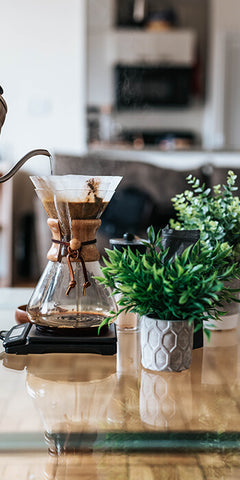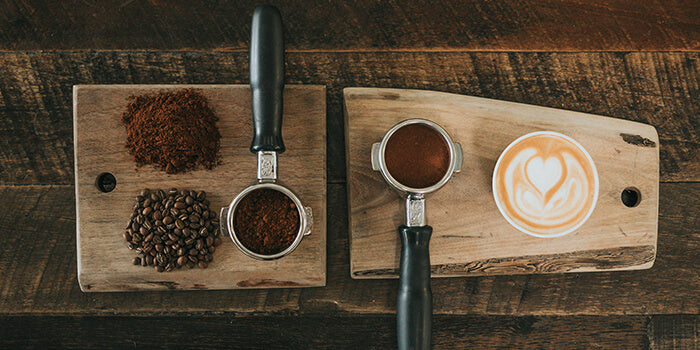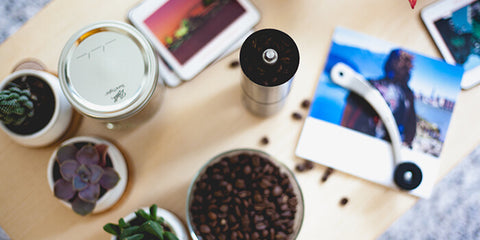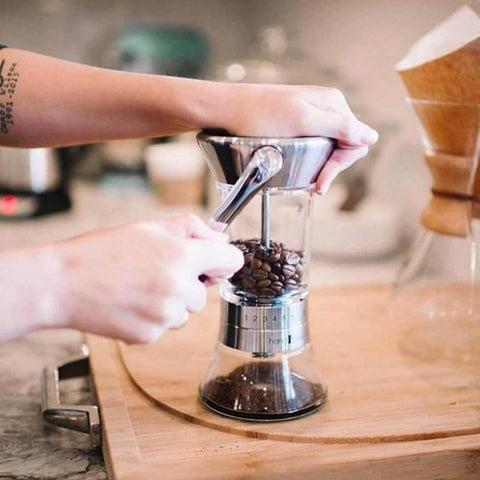
Grind Coffee At Home: The Best Coffee Grinders
If you don’t already grind coffee at home with a burr grinder, it’s likely you’re wondering what it is exactly that makes the coffee at your favourite place so special. How do they achieve that balance, the perfect grind settings, force those sweet and sour notes to play from the same songbook, and pack it full of complexity and nuanced flavour … and why, despite your best efforts, is your home brew just not quite on that level, even if you have your own coffee machine?
The very fact you’re reading this means you have probably already invested in a home coffee set-up, but not a burr grinder. Like many people though, you might not properly understand how important freshness, and grinding with a burr grinder, really is. If you don’t grind your own coffee beans, then you might actually be sabotaging your own best efforts.
How and when you grind your coffee beans is one of the most important aspects of the coffee making process, but it is also the most often neglected.
Trust us; you can get every stage of your process spot on, but if your coffee beans aren’t freshly ground with a burr grinder, you’re never going to achieve barista-quality coffee.
To hit that level you need the right burr grinder, and the knowledge to use it and maintain it correctly. We’ll explain later why it’s important to keep your burr grinder clean. We believe though that once you understand the importance of grinding your coffee beans fresh and possess the know how to grind them correctly, you’ll be able to raise your home coffee game to barista-grade brilliance with a burr grinder.
You might not believe us now, but we’re going to explain how important the burr grinder is, the size of grind, we’re going to give you the science, the kind of grind you need and the best coffee grinders for your brew (and why), and how exactly to use your grinder to attain perfection.
Why Should You Grind Your Own Coffee?
 It’s fair to say that in the Western world, we can tend to be a little bit disconnected from the reality of the produce we use. With coffee, this is perhaps truer than with other products. We talk about this in our post on whether freshly-ground coffee is worth the effort and whether you should invest in coffee grinders. Coffee, or at least the part we see, is the seed of a small berry which grows on a coffee tree or shrub. By the time it reaches our shelves however, ground or roasted, it really doesn’t look much like something that came out of a berry anymore. So maybe this is why it’s easy to forget how important the freshness of coffee really is and why you should use a burr grinder. However, the freshness of our coffee of course makes a huge difference to our experience and the quality of the brew.
It’s fair to say that in the Western world, we can tend to be a little bit disconnected from the reality of the produce we use. With coffee, this is perhaps truer than with other products. We talk about this in our post on whether freshly-ground coffee is worth the effort and whether you should invest in coffee grinders. Coffee, or at least the part we see, is the seed of a small berry which grows on a coffee tree or shrub. By the time it reaches our shelves however, ground or roasted, it really doesn’t look much like something that came out of a berry anymore. So maybe this is why it’s easy to forget how important the freshness of coffee really is and why you should use a burr grinder. However, the freshness of our coffee of course makes a huge difference to our experience and the quality of the brew.
When coffee is roasted, the CO2 contained in it expands and is pushed to the outside of the bean, carrying with it some of flavours in the oils that give coffee its taste. The moment the coffee beans are ground, these gases begin to escape rapidly. The great smell in the coffee aisle? That’s just wasted flavour.
Wasted flavour is the last thing you want! If you get the ground coffee into the water quickly, you can capture most of those flavours. The aromas that we breathe in as we drink the hot coffee are also reinterpreted by the brain as flavour, adding a whole new level of complexity. So the more of that flavour we can retain then, the better.
There’s a reason also that pre-ground coffee is vacuum packed: oxygen, although very good for us, is terrible for many things, as it causes a process known as oxidation. In some metals, this means rust. In food, this means decay. With coffee, even whole beans are prone to the effects of oxygen: as the CO2 is forced to the outside of the bean during roasting, the space it leaves behind is filled with air, which of course contains oxygen.
Whole beans will retain freshness for 2-3 weeks before they begin to decline. On exposure to air however, ground beans will begin to deteriorate, rapidly, within 30 mins. So although the first cup may taste great, your coffee will be devolving at a terrifying rate from there on, as oxidation causes the cells to break down, which in turn ‘muddies’ and diminishes the flavour. The greater the surface area you expose to oxygen, the greater the negative effect. So hoping that your bag of ground coffee will remain fresh beyond the first cup is, in reality, hopeless. It's far better to look into coffee grinders and purchase one so that your ground coffee is always at optimum freshness and flavor.
Not only does ready ground coffee allow aromas to evaporate, but it rapidly increases the rate of decay in what flavour remains. In other words, it’s a lose-lose situation to not grind your beans with coffee grinders just before you brew: and it’s a win-win if you do.
What Kinds of Brewers Can You Use?
Given the wide array of different brewing methods available on the market, there is going to be a difference in how you need to grind depending on your choice of brewer. The beauty of grinding your beans at home though is that you will not be limited to just one brewing method, so if you decide to branch out you will already be covered. The majority of pre-ground coffee comes in a size fine for a coffee pot, but maybe not ideal for other methods. So grinding your own beans not only guarantees freshness but opens the door to a range of brewing methods.
Below we’ve listed some of the more commonly used brew methods and explained what size of grind you should be aiming for, and why.
French Press
The French Press uses a metal mesh to separate and filter the grounds from the coffee you drink. For this reason, you will need a coarser grind. Fine ground coffee may make it through and into your cup making it sludgy, and medium grains will block the mesh, meaning you can’t properly plunge the press. If this is the only coffee you drink, bear this in mind when thinking about the best coffee grinder for French Press.
Pour Over
 Depending on the pour over system you’re using, this will vary slightly, dependent on the thickness of the filter and the rate at which the water drips through. The best coffee grinder for pour over filter coffee may vary depending on the system you use. For example, the Chemex uses a thicker filter, which impedes the water dripping through pretty well on its own, and so a medium coarse grind will allow the water to pass through quickly and stop the coffee brewing for too long. Systems like the Hario V60 though, which have a finer filter and larger drainage hole, will benefit from a finer grind which prevents the water passing through too quickly. So, the best coffee grinder for Chemex may not be the best for the V60 - you will soon have the knowledge to be the judge of this, however.
Depending on the pour over system you’re using, this will vary slightly, dependent on the thickness of the filter and the rate at which the water drips through. The best coffee grinder for pour over filter coffee may vary depending on the system you use. For example, the Chemex uses a thicker filter, which impedes the water dripping through pretty well on its own, and so a medium coarse grind will allow the water to pass through quickly and stop the coffee brewing for too long. Systems like the Hario V60 though, which have a finer filter and larger drainage hole, will benefit from a finer grind which prevents the water passing through too quickly. So, the best coffee grinder for Chemex may not be the best for the V60 - you will soon have the knowledge to be the judge of this, however.
Aeropress
The Aeropress is a very adaptable and easy to use device that can work with various grind sizes depending on the brew time, but generally a medium grind will work best for a longer brew time (2-3 mins), and a slightly finer grind for a shorter brew time is also possible (1 min). This will to some extent depend on your taste and the amount of time you want to spend brewing, but note that a finer grind will make plunging more difficult.
Cold Brew
Cold brew coffee is a unique beast in the coffee making world, with the beans being left to extract for hours not minutes and in cold water not hot. Despite this super long time exposure to the water, cold brew coffee only requires a medium coarser grind to prevent over extraction, depending on the brew time, simply because the water is cold.
Espresso
We will talk about this in more detail below, but the fact that espresso coffee is produced under so much pressure and in such a short space of time means that you need a very fine grind size. To get this right, you will find that a bespoke espresso grinder will be the best option, as they offer greater precision in grind size; and we’ll tell you why this is so important later on.
Pick The Right Grind Size For Your Brew Method
It’s pretty clear from the above that the kind of brew you make will affect the grind size and grind settings you will need to ensure your coffee extracts correctly. You can use this table to make sure you’re starting out in at least the right ‘ballpark’ with the size of your grind.

| GRIND SETTINGS |
BREW |
| Coarse | Cold Brew Coffee, Cowboy Coffee (longer brew time) |
| Medium-coarse | Chemex, clever dripper, cafe solo brewer, Cold Brew Coffee (shorter brew time) |
| Medium |
Flat bottom drip coffee machine, syphon coffee, Aeropress (with 3+ minute brew time), Cone shaped pour over brewers with thicker filters like Chemex |
| Medium-fine |
Cone shaped pour over brewers, Aeropress (with 2-3 minute brew time), Cone shaped pour over brewers with finer filters like the Hario V60 |
| Fine | Espresso, Moka pot, Aeropress (with 1 minute brew time) |
| Extra-fine | Turkish coffee |
Burr Grinders vs. Blade Grinders
By now we hope you are starting to see why grinding your own beans is so important. If you are then you’re probably starting to wonder what type of home coffee grinder you need. The first big decision to make is whether you opt for a blade or a conical burr coffee grinder - but in reality, for coffee connoisseurs, this is not much of a choice. Always go for the burr coffee grinder when in doubt!
Blade Grinders
 Although blade grinders are probably the best budget coffee grinders in terms of cost alone, they aren’t really ‘grinders’ at all. The reason for this is that they use rotating blades (or propellers) to chop and smash the coffee into pieces. Technically, there is no grinding involved. This results in uneven sized grains which extract inconsistently, meaning you are more likely to get bad results. Some grains will under extract, some will over extract, and some will extract right. Sure, with a lot of luck this could result in a great cup of coffee, but we didn’t come this far to start taking crazy risks.
Although blade grinders are probably the best budget coffee grinders in terms of cost alone, they aren’t really ‘grinders’ at all. The reason for this is that they use rotating blades (or propellers) to chop and smash the coffee into pieces. Technically, there is no grinding involved. This results in uneven sized grains which extract inconsistently, meaning you are more likely to get bad results. Some grains will under extract, some will over extract, and some will extract right. Sure, with a lot of luck this could result in a great cup of coffee, but we didn’t come this far to start taking crazy risks.
Also, the blades spin very fast and generate heat the longer they are used, which for finer grind sizes like espresso can burn your coffee before you’ve even got it into water, destroying those wonderful flavours we talked about earlier.
Burr Coffee Grinders
This is why we strongly recommend using a conical burr coffee grinder like the Lume Portable Burr Grinder instead. You’ll never catch a barista using a blade grinder after all, so neither you should you.
Conical burr coffee grinders compress the bean between two abrasive surfaces which properly ‘grind’ the coffee, not chop or smash, and what’s more the beans drop down in to the burr one at a time, resulting in a very consistent grind with a burr coffee grinder. These grinders use either a wheel burr, which are cheaper but produce more noise and mess, or conical burr - generally considered the best burr coffee grinder.
You will also need to consider whether or not you go for a stepless grinder, which we will explain in more detail a little later on.
How Do You Dial in With Your Coffee Grinders?
The reason the size of your grind is so important is because it is one of the primary factors that will affect how well your coffee extracts. Extraction, if you didn’t already know, is the process by which you transfer the flavour of the beans into the water. Understanding a little about this will enable you to not only start in the right ‘ballpark’ with your grind size, but empower you to make fine tunings and dial in the exact setting to your grinder to create your perfect brew.
The science behind extraction is complicated, but basically, the size of grains you will want will depend on the length of time the coffee is exposed to the water, as the surface area that comes into contact with the water will affect how much flavour escapes.
You can identify how well your extraction is working by taste. If your coffee grounds don’t release enough of their flavour into the water, this is known as under extraction. As acids and salts are more soluble than sugars, these are first flavours to be released from the coffee during brewing, and your coffee will taste sour and overpowering. These flavours are present in well extracted coffee also, but are balanced by sweeter flavours released later in the process, mellowing and balancing your brew. Under extracted coffee will also have little lingering flavour.
If you release too much flavour, then you have over-extracted. The bitter, dark tasting notes that are released at the end of the extraction process will overpower the sweet flavours that are released at peak extraction, as well as the acidic, fruity sour flavours, and your brew will be bitter and lack clarity. Over extracted coffee is also astringent, meaning you will be left with a dry, cloying sensation in your mouth after drinking, a sensation which you may recognise if you’ve ever drunk low-quality red wine.
 Properly-extracted coffee will have all the acidic notes present, but balanced by the sweetness of the sugars. This is known as balanced extraction, and your coffee will have fruity, sweet and acidic notes, creating the complex and pleasing flavour we recognise simply as good coffee. It should have a long aftertaste, and will not dry the mouth.
Properly-extracted coffee will have all the acidic notes present, but balanced by the sweetness of the sugars. This is known as balanced extraction, and your coffee will have fruity, sweet and acidic notes, creating the complex and pleasing flavour we recognise simply as good coffee. It should have a long aftertaste, and will not dry the mouth.
When thinking about how exactly to dial in your grinder, start by choosing the ‘ballpark’ grind from the table above. Then, taste your brew. If you recognise from the above that it is under or over extracted, you can make micro adjustments to balance this out. So, if it’s sour and acidic, go for a slightly finer grind. If it’s bitter and dull, slightly coarser. People are often confused by the difference between ‘sour’ and ‘bitter’ flavours. Read about it to tell the difference. This will vary slightly depending on how you brew, but by trial and error, you should soon recognise what’s the ideal grind for you.
Should You Get a Manual or Electric Coffee Grinder?
Really, this depends on you, the coffee you brew and your lifestyle. We wrote about it in our post on Manual and Electric Grinders. If you have a young family or live in a shared house, a noisy electric grinder might not be practical, but if you’re short on time in the morning or you’re brewing for many, it could be ideal. Also if you have an espresso machine and need a particularly fine grind, you may not want to be actually breaking a sweat each time you need a cup of joe, and an easy to use electric grinder will save a fair bit of effort.
If you travel a lot or just like getting hands on with the process (as many of us do), a manual coffee grinder may work for you. These are undoubtedly better if for whatever reason noise is an issue in your environment. There’s also a school of thought that says, as manual grinders turn slower and generate less heat, they retain more nuances in the flavour that might be burned off by a faster, heat generating electric grinder.
| MANUAL | AUTOMATIC |
| Hands-on | Convenient - little effort required! |
| Lighter and more portable if you travel |
Easier to get a more consistent grind |
| Better for those on a budget |
May affect flavour slightly if used for very fine grinds |
| Can elevate flavours | Loud |
| Much quieter |
Love Espresso?
If you love espresso, it might well be worth investing in a grinder specifically for this brew. Espresso grinders offer more precision when you dial in. Stepped grinders offer a range of stepped coarseness settings, for example 1-40, or 1-10 with 4 micro-steps in between, which is enough for most people and most grinds. However, if you make espresso, you could quickly find this limiting.
Stepless grinders like the Lido 3 Hand Grinder, however, offer near infinite grind varieties and grind settings, allowing you to dial in your grinder with total precision. Here, tiny adjustments of the grind settings can make a huge difference to the taste. So if you’re in the market for the best coffee grinder for espresso, we recommend you go stepless. Although generally electric like the Lume Portable Burr Grinder due to the energy involved in grinding the beans so fine, there are also a few very good manual espresso grinders available, with the ability to change grind settings.
Don’t Forget to Clean Your Coffee Grinder
The more you use your grinder, the more residual oils and grains will build up in the mechanism, which over time can affect your grinder's function and eventually affect the quality of your grind. You also risk old degraded grains entering your fresh coffee, which of course is not ideal when you’ve gone to so much effort to keep your coffee as fresh as humanly possible.
For this reason, it is important that you keep your grinder clean, and luckily these grinder cleaning tablets were designed with exactly that in mind.
What's The Best Coffee Grinder For Home Use?
Buying whole beans and grinding them just before you brew you can not only lock in all of those wonderful flavours and aromas but avoid oxidation. With a high quality grinder, and the know-how to achieve exactly the right grind, you can extract those flavours perfectly.
So if you really care about your coffee, we strongly recommend you buy yourself a coffee grinder. We think you’ll be amazed by the difference grinding your own beans can make to your brew. Here are a few examples to get you thinking.
Best Overall Home Coffee Grinder: The Baratza Encore - an entry-level electric grinder from the famous Baratza brand, this is widely regarded as the best for those wanting home-ground coffee at a low price.
Hario Slim - this super affordable manual grinder is small enough to travel with and a great choice if you’re on a budget, on the move, or both.
Compak K3 Touch - an espresso grinder with the ability to make super fine adjustments, and small enough for both kitchens.
Lido Express E - from the excellent Lido, a hand grinder that's tailor-made for grinding superfine for espresso.
We have over 40 grinders available, so if you don’t see one you want above, be sure to check out our full range of manual and electric grinders. We’re sure you’ll find a grinder to suit your specific needs.
 Same Day Dispatch
Same Day Dispatch